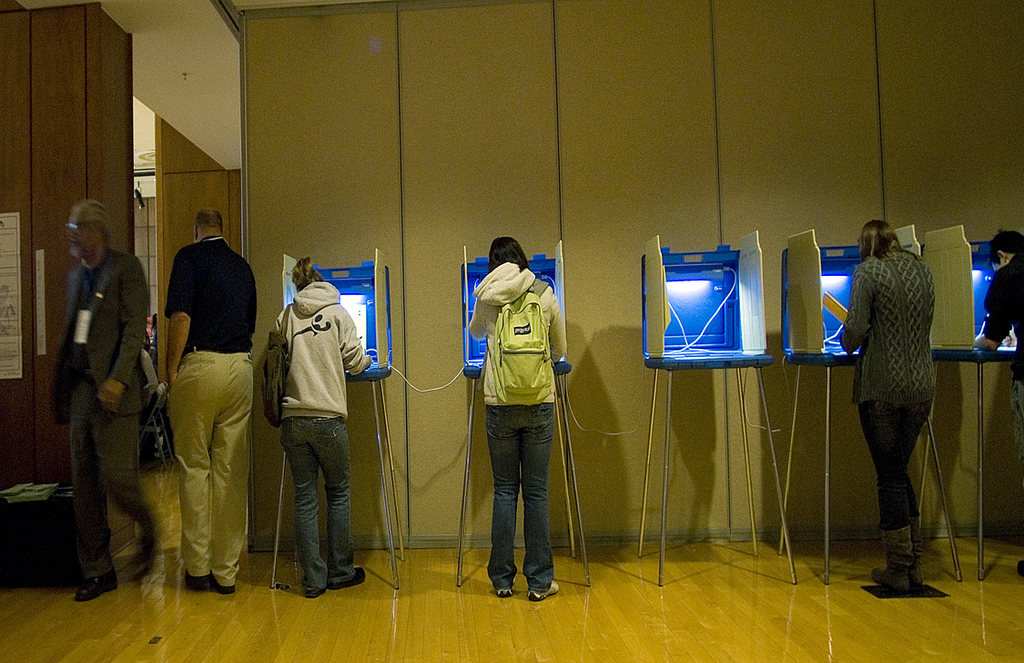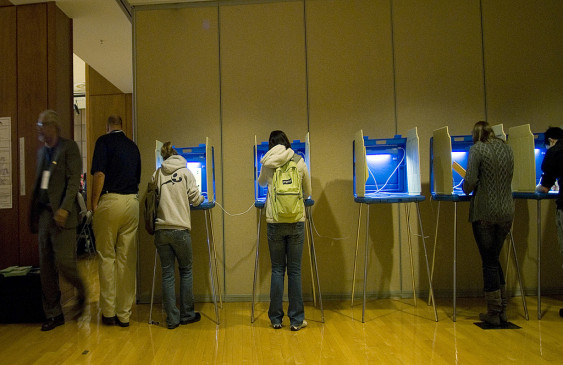This is part two in a four article series about how voters respond to ranked ballots and proportional voting systems. You can read the other articles in this series here: Part 1, Part 3, and Part 4.
Imagine you are running for office and you’ve got a strong base of voters who know you represent their views, values, and hopes for the community. The polls show the race is close, so you need every one of your supporters to cast a vote for you. But, even though they support you, some voters don’t make it all the way down the ballot to your race. Or perhaps once they do get to your race, they make a mistake and their vote doesn’t count. Their voice doesn’t get heard, and you don’t get all the votes you otherwise would have.
Some of the concerns may warrant attention, but on the whole, introducing ranked-choice voting doesn’t increase the rate of uncountable ballots.
Some voting reform activists worry that ranked-choice voting will disenfranchise potential voters because they will be intimidated by the new ballot and not cast a vote, or will be confused by it and make a mistake. Or, if they don’t cast a vote for any of the final candidates, their ballots won’t influence the final election outcome. Some theorists speculate these burdens could disproportionately impact voters of color and low-income communities, widening disparities in representation.
Some of these concerns may warrant attention, but on the whole, introducing ranked-choice voting doesn’t increase the rate of uncountable ballots. Instead, most voters can handle new ballot designs and instructions, with error rates increasing by less than 1 percentage point over plurality elections. When voters fill out their ranked-ballots at home and mail them in, as most voters do in Cascadia, this increase in ballot error is even smaller. Far more impactful, and swamping the slight uptick in voter error, are the major increases in voter turnout and engagement as a result of RCV. Overall, ranked-choice voting elections see a 24 percentage point reduction in the number of voters who don’t have a say in all stages of the election process compared with plurality elections.
In this article I’ll compare rates of voter error and skipped votes in ranked-choice elections versus more common pick-one plurality elections. In my next article, I’ll continue on this topic and compare the frequency of ballot exhaustion—that is, when a ballot contains a valid vote, but has no impact on all rounds of vote counting—between ranked-choice and pick-one, plurality elections.
Three reasons why a vote may not be counted in an RCV election
People may cast ballots with uncountable votes for a particular race in one of three ways. The first occurs when a voter has trouble using her ballot and makes a marking error, say by marking two candidates for president, or giving two candidates the same ranking, rendering her vote unreadable. This case is called overvoting. Alternatively, she may choose to skip voting in a particular race all together, perhaps because the voting method is unfamiliar or she feels she doesn’t have enough knowledge about any of the candidates. That scenario is called undervoting. Finally, she may cast a ballot with a valid vote for a race, but if she doesn’t vote for any of the final candidates in the running, she won’t have a say in the winners. This is called ballot exhaustion and it can happen in RCV and plurality elections. The following three drop-down boxes give more information about how these three types of uncountable votes can happen in either plurality or ranked-choice elections.
Overvoting is rare, and typically a sign of a mistake—either the voter filled out the ballot incorrectly or the vote counting equipment incorrectly read the ballot. In common, pick-one plurality or top-two runoff elections, elections officials typically see an overvote rate of 1 percent or more as cause for alarm. The rate of overvoting remains relatively constant across races, though may be slightly higher in up-ballot races than in those further down the ballot. (People who vote in down-ballot races, such as for school board or sewer district, typically are well-informed voters and less likely to make mistakes.)
To give some Cascadian context, 329 Seattleites overvoted in the 2016 presidential election, meaning they voted for two different candidates, thereby making their ballot uncountable for that race. That was equivalent to 0.08 percent of all Seattle voters who cast a ballot in the general election. Further down the ballot that year, 21 Seattleites made two choices for Commissioner of Public Lands, resulting in an overvote rate of 0.005 percent. Similarly, the overvote rates in Seattle’s 2015 at-large city council races were 0.004 and 0.002 percent, for seats eight and nine, respectively.
By way of comparison, in the 2000 presidential election, several Florida counties had overvote rates of between 4 and 6 percent, and in some very extreme cases of more than 8 percent. But these cases are very rare and almost always indicate a problem with the ballot design or vote-counting equipment.
Undervoting is much more common than overvoting and is often intentional; a voter may skip races either as an act of protest or because she has no opinion about a race. Rates of undervoting vary by jurisdiction depending on what type of races are on the ballot, voting culture, and voting system, such as whether a jurisdiction uses a primary plus general or a general plus run-off system. Position on the ballot also matters with undervoting; voters are more likely to skip races further down the ballot than those in top positions. In Seattle, for example, the undervote rate in the 2016 presidential race was 0.2 percent, but it was 10 percent in the down-ballot race for state commissioner of public lands.
Exhausted ballots are those which have a valid vote in one, but not all, rounds of an election. Though this happens in ranked-choice and plurality elections, the mechanisms are slightly different.
In a ranked-choice election, a ballot becomes exhausted when a voter doesn’t assign a rank to any of the final candidates in a race. For example, imagine a single-winner race with five candidates. Even if a voter assigns ranks to candidates one, two, and three, if all those candidates are eliminated via subsequent rounds of counting, her ballot will have no influence over the final face-off between candidates four and five. Ballot exhaustion becomes less frequent as voters use more of their available rankings, but is always a potential issue so long as voters have fewer rankings than there are candidates.
In a plurality election, ballot exhaustion is the difference between voters in a primary or runoff election and voters in the general election. For example, if a voter doesn’t vote in the low-turnout primary, but does vote in the general (as is very common since primary elections have notoriously low turnouts compared with general elections), she will have a say in the final winner, but had no say in who made it to the general election ballot. Only voters who turned out for the primary had any say in how the original pool of candidates was narrowed. Similarly, if a voter votes in a November general but not in a winter runoff, she has no say in the final winner, even if she did get to weigh in on who the final two candidates were.
I’ll explore the issue of ballot exhaustion in my next article.
Over- and undervoting don’t change overall voter participation
Only a few studies compare the rate of uncountable ballots between elections using RCV with those using plurality voting. The evidence that does exist suggests that, generally, overvotes increase slightly with RCV while undervotes decrease (in other words, more people participate in down-ballot elections when jurisdictions conduct them via RCV, but these voters also make more mistakes than the usual well-informed down-ballot voters). Together, these opposite trends nearly balance each other out, leaving the overall rate of uncountable ballots in RCV races unchanged. The most comprehensive study of the combined impact of over- and undervotes found that RCV cities see a decrease in uncountable votes of about two percentage points compared with cities using plurality ballots. That decrease isn’t large enough to be statistically significant, but suggests that these mechanisms don’t noticeably move the needle on uncountable ballots.
Data from San Francisco’s RCV races show that the rate of overvoting increases in RCV elections by one percentage point or less compared with pick-one plurality races. Data from other Bay Area cities using RCV, including Berkeley, Oakland, San Francisco, and San Leandro, confirm this: overvote rates in these cities hover around 0.3 percent, a jump from the more standard 0.1 percent of SF voters who overvote in non-ranked races, including for president, and US Senate (also here).
Interestingly, the slight uptick in overvoting doesn’t appear to be due to ranked-choice voting specifically, but to an increase in voting complexity in general. For example, a plurality bloc voting race on the same ballot as an RCV race resulted in a similar increase in overvoting compared with the pick-one plurality races on the ballot. Still, this increase in overvotes in either the bloc voting or RCV races is so small that it is extremely unlikely to tip the scale and change an election outcome in all but extremely close races in precincts with very small turnout.
There is not sufficient long-term data on RCV to determine whether the bump in overvotes decreases with time, as voters become more comfortable with the voting method. Intuitively this makes sense, but data from at least the first seven years of RCV voting in San Francisco don’t show a clear trend.
In addition to increased ballot complexity, voters are also more likely to overvote when they have to choose from a longer candidate slate. But, having more candidates on the ballot also appears to reduce undervoting (studies from multiple cities confirm this). In other words, though having more candidates on the ballot may open voters up to more mistakes, it also appears to engage them more in an election, perhaps by increasing the chances that they’ll feel a candidate represents them well. This may particularly serve voters of color who often see the greatest relative increase in preferred candidates on the ballot, as I’ll explore below.
Cities that adopt RCV also see a slight drop in undervoting on ranked races compared with their plurality elections. For example, in San Francisco’s first RCV election in 2004 two ballot studies found a lower rate of undervotes (also here) in the municipal, ranked elections compared with the non-ranked races on the ballot. More recent data through 2012 suggests that this decline in undervoting has continued nearly a decade post-adoption.
Taken together, the modest bump in overvoting and dip in undervoting lead to very little, if any, change in the rate of uncounted votes.
Some voter groups are more likely to make errors in all voting methods
Gaps in overvote rates between different voter demographics—for example, by race, ethnicity, and income—persist across all voting methods. For example, African American voters in San Francisco’s plurality, bloc, and RCV elections are more likely to overvote than White, non-Hispanic voters in these elections. Latino and Asian-American voters are sometimes more likely to overvote than White voters, though this doesn’t always hold true in RCV races. Older and foreign-born voters also have slightly higher rates of overvoting in some RCV and plurality elections than younger, or US-born voters, respectively.
Since the gap in voting error rates exists in plurality and RCV races, the more important question is whether RCV increases this gap. Unfortunately, there are no robust data on this question. Existing data suggests that error gaps likely change very little (and here), if at all, between RCV and plurality races across socioeconomic, racial, or ethnic groups. Data from Minneapolis found that overall uncountable ballot rates actually decreased in wards where the majority of eligible voters identified as people of color. This was likely because these wards saw a particular increase in candidates on the ballot, leading to marked decreases in undervoting as more voters saw an option they liked (similar data from other jurisdictions here).
Another study found that the voter error gap may actually decrease slightly in RCV races for foreign-born and older voters, but may increase slightly between African American and White voters. But, these data are so thin that they offer little confidence. Overall, the tweaks to voter error rates are small enough to be extremely unlikely to alter an election outcome. Far more impactful to voter participation is the massive increase in voter turnout as a result of RCV, which particularly boosts turnout among voters of color.
Voting by mail decreases overvotes
Cascadia may be particularly well suited to ranked-choice voting. Ballot analyses show that voting by mail significantly reduces overvoting in RCV elections compared with completing RCV ballots at the polls, possibly because voters have more time to contemplate their ballot in their own living room instead of rushing through it in a cramped polling booth. Oregon and Washington vote by mail, so Cascadian voters in the US are even less likely to experience increases in overvoting than voters in other RCV jurisdictions.
Conclusion
Many voting theorists and democracy reform advocates worry that issues like voter error and voter fatigue in ranked-choice elections will disenfranchise voters, but these concerns are unfounded. Though voter error does increase slightly in RCV elections, this uptick is met by a similar rise in participation via notable decreases in undervoting. What’s more, and as I’ll explore in my next article, any rise in error rates is overwhelmed by the increase in voter turnout thanks to a streamlined election process. Overall, ranked-choice voting is one of the most powerful tools Cascadia has to increase participation for all eligible voters in elections.











